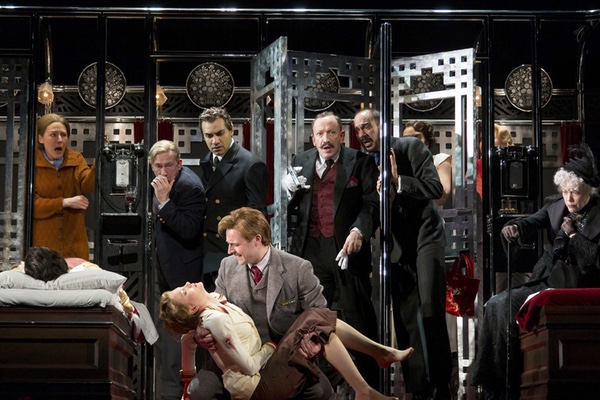First Class Travel on the Orient Express

Suddenly, on stage, there is Belgium detective Hercule Poirot, the great creation of 1930s British novelist Agatha Christie. He introduces the story of the Orient Express, the high speed luxury train that connects Istanbul to Calais, France. He is brilliant He is charming. He is suave. And he is about to board the legendary Orient Express itself and become the central character in Christie’s classic murder mystery, Murder on the Orient Express, revived yet again at the McCarter Theater, in Princeton, N.J.
The alleged murderer of a young child in America, disguised as Samuel Ratchett, has fled to Europe and is discovered, very dead, on the train as it hurtles northward through the Alps from Istanbul. Who did it? Poirot, as prim and proper as ever, grabs the case by the throat and begins to grill passenger from every country and walk of life in an effort to bring the killer to justice. He chases theories, dabbles with evidence, listens to advisors, puts up with some intolerant passengers and, finally, solve the homicide – with one very wild finish to the story.
The Princeton drama, that opened Friday, adapted for the stage by playwright Ken Ludwig and directed with a deft hand by Emily Mann, is just terrific. Mann puts you on that train in the winter of 1934, halted by a snow avalanche and never lets you go. You are in for an evening of thrills and spills, killers and accomplices, mystery conductors and lying through their teeth passengers. It is one of the best ever stagings of the play and story.
Mann and the playwright start by defining a wide ranging group of fascinating characters, any of whom could have stabbed the victim (eight times). They are very believable suspects for Poirot to throttle, and he does, one by one. There is the conductor, a royal couple, an aging American woman, a singer and others (Christie had twelve suspects but Ludwig wisely narrowed them down to eight to make the story move faster).
The success of the play is Christie’s ability to tell a story in a finite setting, the train, over just a period of several days. The success of the McCarter production is to make the story as viable today, in 2017, as it was nearly 100 years ago. The theater does that, and with a loud burst of a train whistle.
Director Mann has fashioned the story in a delicious way, keeping the action moving and, importantly, creating a marvelous, ornate set of train cars (designed by Beowulff Boritt). The play begins with the wail of a train whistle and then the train hurtles right at the audience. The train cars move slowly. You feel like you are watching a movie at times.
The eight suspects on the train, all dressed nicely in 1930s clothes, form a delightful cadre of prospective villains. In their interactions with Poirot they engage in wonderful story telling and fearmongering and have some very funny lines. In one scene, a suspect tells Poirot that he admires his pipe and Poirot shots back that he’s thinking of British sleuth Sherlock Holmes.
Director Mann also puts a certain magic into the story. You know that the time is 1934, but the play does seem aged at all; it seems as fresh as this morning’s Amtrak racing towards Washington, D.C. She gets fine work from a skilled group of actors. They include Maboud Ebrahimzadeh as the conductor, Max von Essen as Colonel Arbuthnot, Susannah Hoffman as Mary Debenham, Julie Halston as Helen Hubbard, Juha Sorola as Hector MacQueen, Veanne Cox as Princess Dragomiroff, Samantha Steinmetz as Greta Ohlsson, Evan Zes as Monseur Bouc, Ivy Cordle as Daisy Armstrong, and Alexandra Silber as Countess Andrenyi.
Allan Corduner is just dazzling as detective Hercule Poirot.
The play is just as good as the stellar movie version of the story produced in 1974, which many still remember.
The history of the play is intriguing. Novelist Christie, the author of so many best sellers, boarded the train in 1928 following the breakup of a romance. On that trip she met a dozen or so colorful passengers from different parts of the world and decided to write a mystery of some kind set on the train. She rode the Orient Express several more times over the next few. Years. One time the legendary train was stuck in a snowstorm and on another excursion was halted in a flood. Those ecological disasters all appear in this play and trap the train for enough time for Poirot to do his intrepid investigating.
The train always intrigued Christie. “All my life I had wanted to go on the Orient Express. When I had travelled to France or Spain or Italy, the Orient Express had often been standing at Calais and I longed to climb up into it,” she wrote in her autobiography, some of which appears in a fine McCarter program story about the play (the McCarter staff thankfully always inserts history stories into its program).
The Orient Express will intrigue you, too, as its charges through the countryside, murder most foul on board in this delightful staging at the McCarter.
PRODUCTION: The play is produced by the McCarter Theater, Sets: Beowulff Boritt, Costumes: William Ivey Long, Lighting: Ken Billington, Sound: Darron L. West. The play is directed by Emily Mann. It runs through April 2.